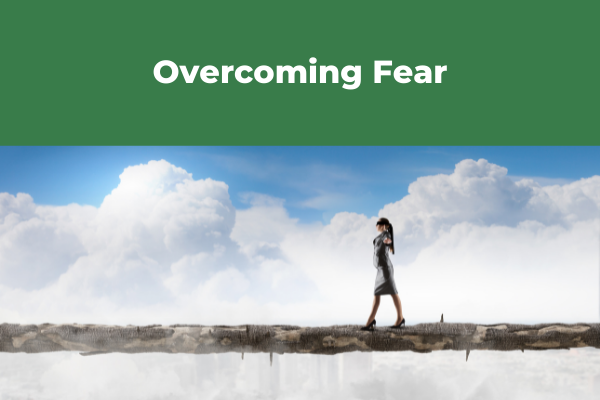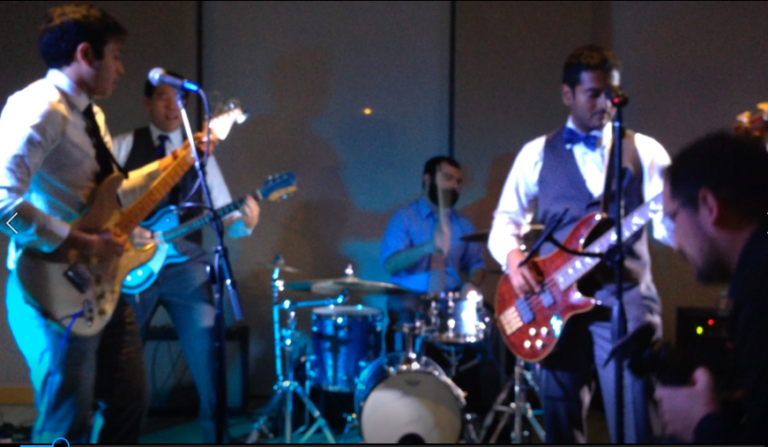This week’s post will build upon last week’s post The Misapplication of Fear in Modern Society.
Today, we will explore 1) what we’re truly afraid of, 2) how confronting those fears, instead of trying to bypass them, helps us vanquish them, and 3) how to actually confront those fears.

What We Really Fear
From last week, we know that fear and irrational fear are a part of life.
True fear has its uses. Irrational fear, on the other hand, stands between where we are now and where we want to be.
It’s important to note that we don’t fear the thing that invokes irrational fear itself. Instead, we fear the emotion that may arise from that thing.
For example, we don’t actually fear public speaking. We fear the potential shame, embarrassment, ridicule, or humiliation that our brains tell us may result if we fall flat on our faces doing so.
Side note: Public speaking is the number one fear for Americans. Over 25% of people fear speaking in front of a crowd!
Part of overcoming these fears is recognizing that what we truly fear are actually simply unpleasant emotions. More specifically, we are afraid of feeling those unpleasant emotions.
Emotions Vs Sensations
Emotions (a.k.a feelings) are simply vibrations originated in our brains and experienced in our bodies. They come from thoughts. Every emotion is a manifestation of our underlying thinking.
This is in contradistinction to sensations—things originated by our bodies like hunger or fatigue or coldness or warmth. We often use the word “feel” to describe both emotions and sensations, which is why it is easy to conflate the two.
Continuing our example: you are having a thought about public speaking like “I’m not a born or natural speaker” that’s going to make you worry about humiliating yourself if you were to speak in front of others.
In this case, your fear is like your Spidey Sense putting you on alert. Some people experience their fear of public speaking as butterflies in the stomach or a knot in their throat. It feels as real to them as does their hunger or fatigue because there is a physiologic response when the brain puts them on high alert that there is “danger.”
My Spidey Sense tells me…to keep on reading.
Fear Requires Mind Management
Your brain is equating public speaking with being confronted by a bear.
I know you’re going to ask me, “but what if it’s a bear that’s asking me to give a lecture?” to which I would have to respond, “either stop using the hallucinogens…or at least share them.”
This misapplied fear is actually a mismanaged mind because this kind of fear is actually harmless. Nothing can actually hurt you from feeling an unpleasant emotion.
Unfortunately, we avoid doing anything that brings up unpleasant emotions even if everything of our dreams resides just past those emotions.
Brooke Castillo of The Life Coach School says that the best parts of life, the things we want, are on the other side of fear. I wholeheartedly agree.
How do we avoid these unpleasant emotions? We make excuses to avoid addressing our fear. We tell ourselves avoidant thoughts like “I don’t know” or “I’m confused.”
Fee Fie Phobia
It’s useful to briefly compare the irrational fear we experience to actually pathologic fear—that is, phobias.
Specific phobias are defined in the DSM-5 (the fifth iteration of the Diagnostic and Statistical Manual of Mental Disorders) as anything that is “avoided or endured with intense fear or anxiety out of proportion to the actual danger posed by the phobic object or situation and to the sociocultural context.”
Examples include fear of heights (acrophobia), spiders (arachnophobia), or peanut butter sticking to the roof of your mouth (arachibutyrophobia—it’s a real thing).
What’s the R0 for agoraphobia?
As you can tell, a phobia is in line with the type of fear being discussed here, but further out on the spectrum of severity.
Treatment for phobias includes exposure therapy and desensitization, both of which can be used to similarly tackle the everyday fears that hold us back.
Sun's Out, Self-Confidences Out
The good news is that you don’t have to be fearless to overcome your fear. You do have to learn how to embrace your fear and force your way through it. You cannot simply detour around it.
As I mentioned in the concluding remarks in last week’s post, when you experience the unpleasant emotions, first recognize that this is your brain’s natural fear response.
Tell yourself this is okay and show yourself compassion for doing the normal human thing.
Next, you have to learn to flex your self-confidence muscle, and the only way to do that is to practice doing it.
You need to build courage or self-confidence—that is, belief in yourself that you can do hard things even if you’ve never done them before.
This belief will become your overriding thought above all else, even when your brain would otherwise like you to feel fear instead.
Ride That Fear
You have to put yourself in situations where your fear response kicks in and demonstrate to yourself that feeling those feels is, in fact, harmless. Prove it to yourself.
No, I’m not talking Fear Factor here. I’m talking about signing up to give lectures if you’re afraid of public speaking.
What’s the worst that could happen? You fall flat on your face on the way up to the podium? You actually forget to put pants on? You don’t move the audience to tears? You aren’t subsequently selected to give a TED talk?
Yes, maybe your mouth was dry, you stumbled over phrasing once or twice, and you sweated profusely (oh, that’s just me?), but, by golly, you showed up and gave the lecture!
Allow yourself to feel those unpleasant emotions. Let them course through your body. Generate your own evidence that they don’t hurt you. Take action in spite of them.
Now do that nine more times, and, baby, you got a stew goin’.
And by “stew” I mean a badass speaking gig!
If taking the plunge and signing up to give a lecture is too much, then break it down into smaller steps. Incremental action will get you to your destination.
Drum Roll, Please...Oh Wait, That's Me!
I played the drums in a band in college and med school. It took me probably 10 live gigs before I didn’t feel like dying playing in front of audiences.
Before then, my muscles would be tight and not follow the instructions from my distracted brain on how to play some of the faster parts. I was too worried about what would happen if I messed up. How would I ever live down the humiliation?
I would end up “dumbing” down those faster parts to easier-to-play shadows of their former selves. Worse still, by being distracted, I wasn’t fully present with my bandmates and that made it more likely for me to actually make a mistake, like forgetting where I was in a song or missing a transition!
However, as a band we wanted to share our love of music with our friends and classmates so we kept putting ourselves out there. Over time (and gigs) those nagging thoughts of worry died down. I was building confidence in my ability to perform live as well as self-confidence that I could figure out new situations that would arise.
An example of the latter can make this clear.
The second to last time we played together was 3.5 years after we had to disband because we all went our separate ways for residency.
It was at our bassist’s wedding, and there were all kinds of twists and turns that I had to navigate:
We were playing with a new bandmember with whom I had never played before. More significantly, we never got to rehearse together before playing. Yep, after a 3.5 year hiatus we were winging it together!
And I was playing on the wedding band’s drum set which turned out to be a jazz/bop kit that had no crash cymbals. In fact, where a crash is traditionally set up, they had a second large ride cymbal that I had to use as a crash.
Without going into the details of different types of cymbals (trust me, don’t get me started), it ran the risk of drowning out the rest of the band, so I had to play it very differently than I normally would.
(He's Still Going On About This?)
In fact, as the drummer, I always have to be conscious of my relative volume to my bandmates. They can turn knobs to adjust their volumes but I actually have to adjust how I play—softer or louder—to fit in with the overall volume, which itself can be challenging.
Oh, and did I mention their drummer was about 6” shorter than me so everything was set super low for me. (It is drummer code/common courtesy to not adjust things when using someone else’s drum set especially when they’ll be playing immediately after you).
At this point, you might be thinking that drummers have it hard…and you’d be correct! But that’s not the point. The point is I had the self-confidence to figure it out as went and not let all the potential obstacles, and their resultant unpleasant emotions, stop me.
In fact, my brain was free from the mind drama so that I could just sit down, play, and enjoy a brief throwback to our musical med school days of yesteryear!
Don’t believe me? Check it out:
(Clicking the image above or here will take you to a YouTube video).
Not too shabby all things considered, eh? Now, some may call me a hero for overcoming all odds in that performance—
What’s that? No one would? Oh—harumph!
Start from the End
It may seem easy just to say “build your self-confidence” and maybe you’re rolling your eyes at me, so I want you to answer the following questions:
What are the things you want in life or want to accomplish in life? Write down a list of these things.
Now, what is keeping you from achieving these and creating the life you want?
Whatever obstacles you’ve identified may seem like external factors, but chances are that they are mostly mind drama related to unpleasant emotions.
So what unpleasant emotions come up that you want to avoid? Write them down.
Seek out situations that generate these unpleasant emotions as mentioned above. Embrace them. Once you learn that nothing bad comes of simply feeling them, you can move past them to that life you want.
Challenging yourself in this manner—overcoming your fears—is how you grow. The magic lies in transformation and not optimization.
As George Bernard Shaw says: “Life isn’t about finding yourself. Life is about creating yourself.”
So get out there, vanquish that which holds you back as laid out above, and create your best—or most prosperous—life!
Fear of feeling which unpleasant emotions holds you back? How can you put yourself in situations to show yourself there’s nothing to actually fear? Let me know in the comments below!
If you haven’t subscribed to my email list, then do so below so you don’t miss my new posts or my weekly updates (only for subscribers).
I’d also be most appreciative if you shared this post with anyone whom you think would benefit from the content or message of the blog. They may similarly be most appreciative 

